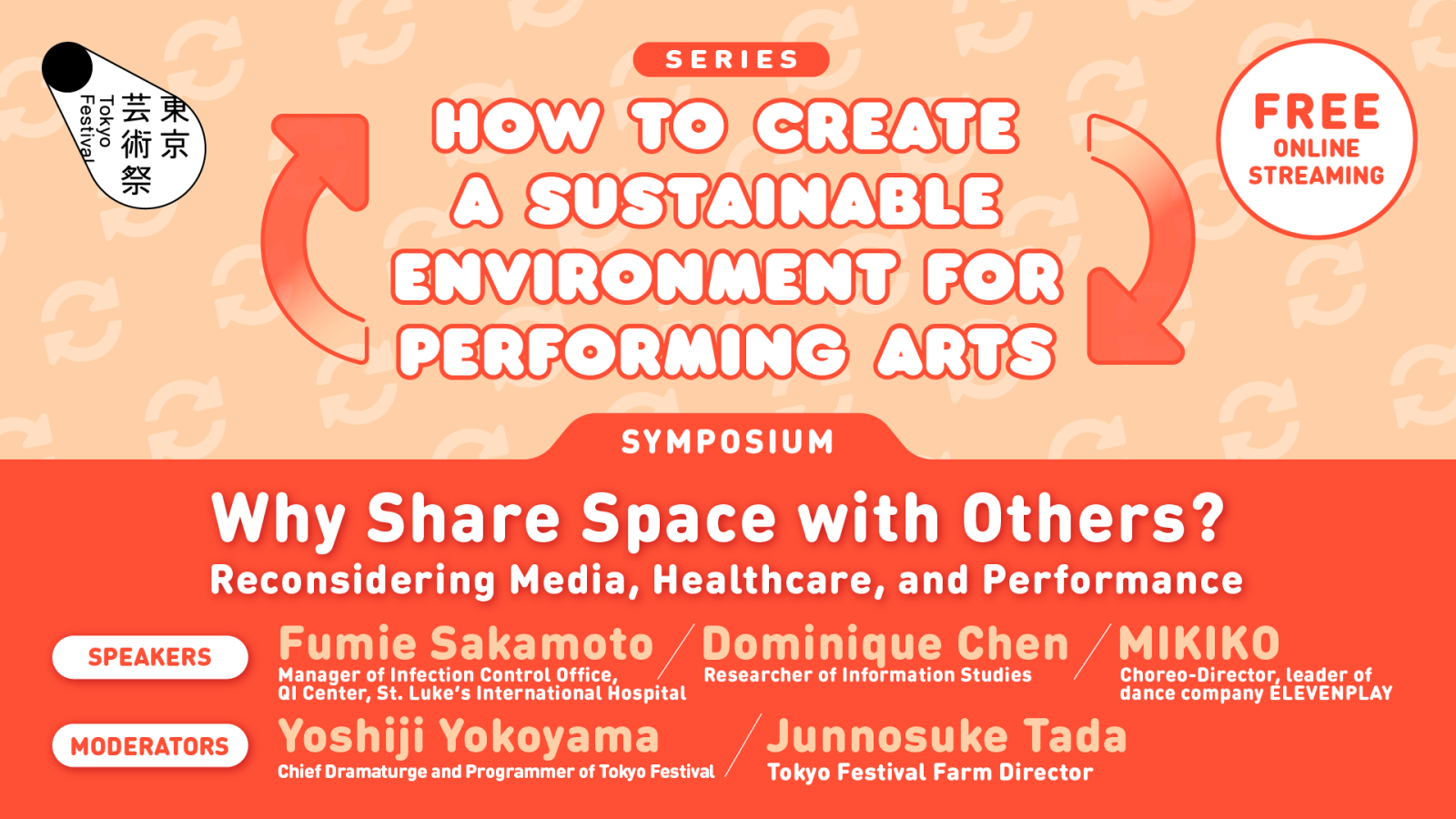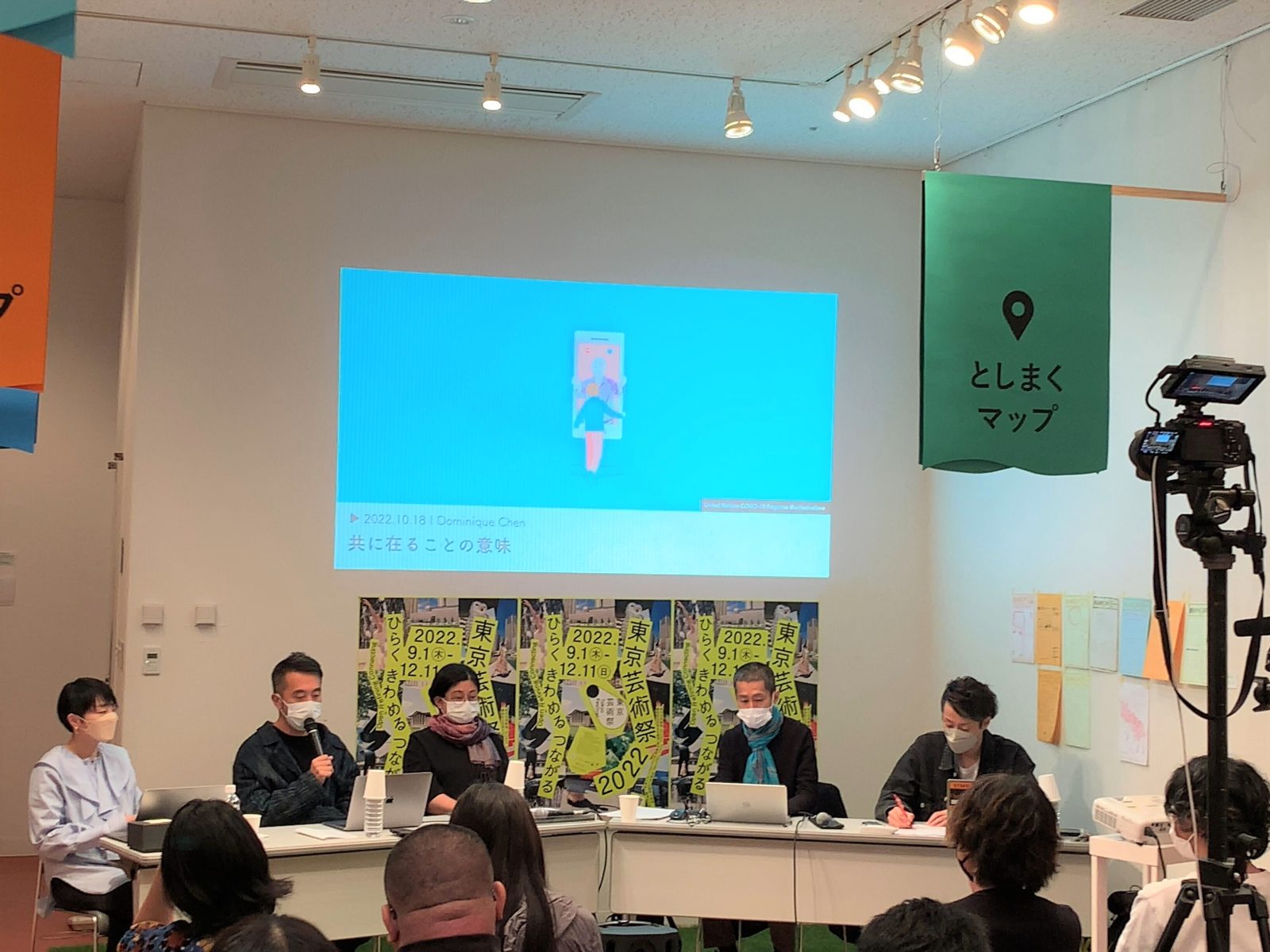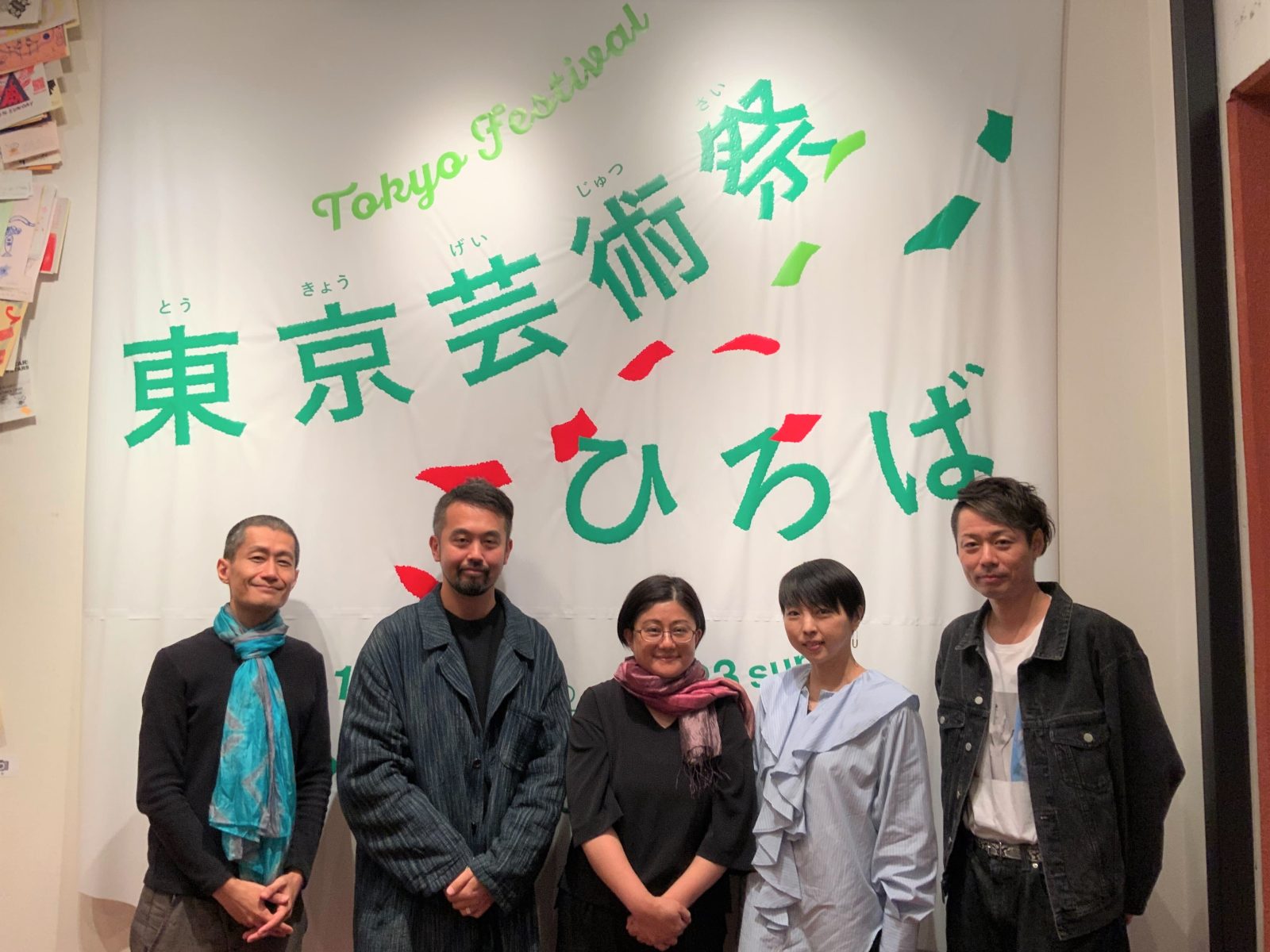SPECIAL

Report on Tokyo Festival 2022 Symposium “Why Share Space with Others? Reconsidering Media, Healthcare, and Performance” (Series – How to Create a Sustainable Environment for Performing Arts)
Original Text: Symposium Production Team
English Translation: Christopher Gregory
Why discuss the topic of why to share space with others? In moderator Yoshiji Yokoyama’s introduction, he naturally made the point that the pandemic has made it more difficult to share physical space. Furthermore, he noted that, as anyone can see by looking at tools like Google Maps, these days physical spaces are mapped as virtual spaces, and both types of spaces exist in a state of mutual dependence. This raises the question of how, in this present moment when it is possible to live in virtual spaces with a sense of reality that is similar to being in a physical space, we should think about the significance of both the act of sharing physical space and also the performing arts themselves, which require (or are thought to require) shared physical space as a necessary condition of the art form. That, more or less, is the question that this symposium takes as its starting point.
After the moderator’s introduction, the three panelists each gave their own presentation. The first speaker was Fumie Sakamoto. As a specialist in preventing the spread of infectious diseases, it was anticipated that she would provide a rigorous overview of both the risks of “sharing space with others” and also the potential responses to those risks. Indeed, her presentation, titled “Sharing Space in a Pandemic,” met those expectations head on. Her presentation neatly laid out the issues at hand, beginning by defining “infection,” then discussing the specific risks of infection by Covid-19 and explaining the effectiveness of various countermeasures.
What stood out about Sakamoto’s presentation was that (and this might be a touchy way to put this) it was not a mere recitation of cold and clinical scientific facts. Instead, Sakamoto called on the audience to draw upon their imagination. As she presented facts (empirical data) about topics like Covid infection numbers and the effectiveness of various preventative measures, she made an appeal to the audience to imagine the specific reality of those facts. This stance was most readily apparent in the sections of the presentation when Sakamoto laid out the effects of Covid by dividing them into two categories—what can be seen by looking at the numbers and what can be seen by looking at individual stories. By drawing on anonymized examples of real patients after presenting quantitative data like the number of deaths, the rate of severe cases, and the rate of death, Sakamoto created an impactful narrative of specifically how the reality of Covid infection, including the long-term health problems and risk of death that may follow, affects people on an individual level. (In fact, it might be fair to say that imagination plays an essential role in preventing the spread of infectious diseases. In the free discussion during the latter half of the symposium, Sakamoto noted that it is easy to understand the relationship between yourself and a friend, but infectious diseases can expand beyond those direct relationships, indirectly reaching an elderly person one step removed or an infant two steps removed from that friend. Thinking about how to prevent the spread of infectious diseases arguably requires possessing enough imagination to consider the many others who exist beyond a visible other right before your eyes.)
You could say that, overall, the essence of Sakamoto’s presentation was in emphasizing the complex reality of the pandemic while calling for a more sophisticated approach to both our awareness of and consideration for that complexity in order to meet the demands of that pandemic reality. Sakamoto noted that, in the field of epidemiology, “infection” is understood to be the result of the complex interplay of three factors: the agent, the host, and the environment. (This model is known as the Epidemiologic Triangle.) Since these three variables differ in each individual case, this is not a discussion that amounts to simply saying either “you will be infected if you do this” or “you won’t get infected if you do that.” The effect of wearing a mask, the effect of vaccination, and the risk of meeting another person are all a matter of probability, not answerable with 0 or 1 alone. It is not a problem that can be reduced to a binary choice, abandoning any consideration or reflection. Sakamoto’s message that “risk can’t be erased, only reduced” and “you need a combination of preventative measures, not a single silver bullet” was clear and memorable.
The second speaker was Dominique Chen. In a presentation titled “The Meaning of Shared Existence,” he drew on knowledge from his expertise in the fields of information studies and media theory to give an introduction to his recent artistic work and current areas of research, and he also discussed his experience doing post-Covid Noh with his Noh instructor Noboru Yasuda in a VR space, also known as Metaverse Noh. In this report, I would like to focus in particular on two topics: the concept of “social presence,” which was the core of the presentation, and Chen’s work with the software program TypeTrace.
According to Chen, social presence is a concept researched in the fields of psychology and engineering, and it is defined as “the degree to which someone who is communicating from a distance feels like they are ‘really there.’” An example of this can be found in the 1976 book The Social Psychology of Telecommunications* authored by John Short, Ederyn Williams, and Bruce Christie, which Chen introduced in this presentation as a pioneering work on this topic. This book details experiments conducted to compare the strength of social presence between letters, audio only communication, audio and video based communication, and in-person communication. The results were not surprising. As you might imagine, audio only communication had more social presence than a letter, social presence increased when using both audio and video, and it increased even further during in-person communication. Fundamentally, increasing the amount of information and adding more sensory modalities increases social presence. However, there are also research findings that suggest this simple view of social presence is not the whole story. In another experiment by Short, Williams, and Christie, they discovered that, in a comparison between meetings conducted with only audio, with video and audio, and in-person, participants’ opinions changed most easily during audio only meetings. So, in that case, if “The Meaning of Shared Existence” is to “exert influence on an other,” might it be accurate to say that an audio only meeting enables a greater feeling of “shared existence” than an in-person meeting? Or should this rather be understood to mean that the influence that occurs during in-person communication takes place on a more complex level, that it is something not contained within the dimension of whether or not opinions change? In either case, this research suggests that it is impossible to comprehend presence with a one-dimensional approach, and we should instead think about how there are multiple different types of presence (and different communication methods that are most suitable to each type).
TypeTrace, discussed in the second half of Chen’s presentation, is a piece of software developed by Dividiual, a company co-founded by Chen and artist Takumi Endo. It records the process of typing, including information about temporal sequence. So, when you replay that recording, it is like an exact recreation of text appearing on the computer screen as the data was input, showing moments including the user going back to correct typos and idle time passing as the user searches for the right words. In art installations presented at exhibitions like the Aichi Triennale, Chen and his collaborators combined recorded TypeTrace data with linked keyboards that typed automatically to match that data, creating the appearance of words being continuously typed out on keyboards that move on their own, with no human present. Normally, when we take in text-based information, we only take in the final product as a static object. However, if you look at that act of typing as a process, even merely seeing text flicker across a screen is enough to create the feeling that you can sense something like the presence of a living human being. This was a thought provoking example that raised questions about what (one of) the elements that constitute presence might be.
*Short, John, Ederyn Williams, and Bruce Christie. The Social Psychology of Telecommunications. London; New York: Wiley, 1976.

The third speaker was choreo-director MIKIKO. She is the founder of the dance company ELEVENPLAY, and she has choreographed stage performances and music videos for a wide range of popular music artists, including Perfume and BABY METAL. Both ELEVENPLAY and Perfume have engaged in a succession of collaborative projects with Rhizomatics, a team of creators who are active in the field of media art. This presentation, titled “From the Frontlines of Live Performance,” provided an introduction to MIKIKO’s various attempts to explore the relationship between the body and technology, from before the Covid pandemic to the present day. First, she provided a chronological introduction to a selection of works by ELEVENPLAY that made extensive use of that moment’s cutting-edge technology, including iPads, drones, VR head-mounted displays, and a next-generation electronic wheelchair called the WHILL. Next, she provided an overview of her experiments with Perfume.
According to MIKIKO, Perfume actually began exploring the possibilities of online streaming and remote screenings that do not require physically going to a performance venue in 2015, aiming to create new value for remote screenings of live performances. Perfume’s seamless fusion of live performance video with pre-recorded 3D video imagery making use of morphing technology and free-viewpoint video was fascinating, but FUTURE-EXPERIMENT VOL. 1 Eliminate the Distance and “P.O.P.” (Perfume Online Present) Festival were the two pieces that were of particular interest in relation to the topic of this symposium. The former was an NTT Docomo project and a proof-of-concept experiment for 5G high speed communication technology. In this piece, the three members of Perfume did a simultaneous performance while separated from each other in three different cities: Tokyo, New York, and London. Video from the New York and London performances was transmitted to Tokyo via fiber optic cables and 5G WiFi, and this was combined with video of the Tokyo performance and streamed live. The aim of this project was to take performances in three cities separated by a distance of 10,000 km and synchronize them with no time lag. In addition to demonstrating that it is technologically possible to overcome the time lag that is thought to inevitably accompany all online communication, it was also an impressive experiment because of the virtuosic mastery of the performers—while scattered across the world, they all came together to execute the kind of high precision performance that demands perfect synchronization in the first place.
In contrast, “P.O.P.” was an online festival held in September 2020, when there were still extremely severe restrictions on in-person events as a Covid prevention measure. On the main page of a website created for the festival, there were a number of buildings rendered in 3D and viewable from 360 degrees. When the website opened on the afternoon of the day of the performance, a wide variety of content (events), including some content that was pre-recorded, began taking place simultaneously, just like an actual festival with multiple stages for simultaneous live performances. Then, that evening, the festival culminated with a live streaming performance by Perfume. More than just a simple live stream, “P.O.P.” included a wide variety of clever ideas to artificially recreate the spatial and temporal aspects of a real festival venue, driving home the potential of online events.
The discussion in the latter half of the symposium was grounded in the content of the three presentations discussed above. It primarily consisted of a further exchange of opinions regarding online spaces and technology in comparison to physical spaces and human corporeality, both in terms of what differentiates them and their unique potential.
To conclude the discussion, Yokoyama made the point that the performing arts have always been compatible with virtual spaces. In the performing arts, a performance comes into being via some point of reference that predates the performance itself, such as a dramatic text or choreography. In other words, performance references a separate temporality, and, through this, the performing arts come to contain within them virtuality, which is the excess that breaks away from the here and now of a performance. Considered in this way, the performing arts do not exist in opposition to online virtual space, inextricably moored to physical space. Rather, the performing arts can be understood as connecting both types of spaces to each other, and as uniquely possessing an inherent stockpile of the assets necessary for an ongoing relationship with the virtual.
It became clear over the course of this day’s discussion that virtual space contains a wide array of possibilities, but, at the same time, it can never become a perfect replacement for physical space, nor should it be. Virtual and physical spaces each possess their own unique characteristics. They are not interchangeable or equivalent, nor is one subordinate to the other. Each needs to be explored according to its own unique characteristics, and it could be said that the work of the performing arts is precisely that very same previously mentioned act of connecting physical and virtual spaces.
While rightly recognizing the utility of communication in virtual spaces and continuing to keep them in mind, those of us in the performing arts should continuously reevaluate the meaning of physical encounters whenever they occur, and we should continue to invent new types of encounters. That is where the potential lies for the post-Covid performing arts, and for our post-Covid shared existence.

Tokyo Festival 2022 Symposium “Why Share Space with Others? Reconsidering Media, Healthcare, and Performance”
Part of the How to Create a Sustainable Environment for Performing Arts Series
by Fumie Sakamoto, Dominique Chen, MIKIKO, Yoshiji Yokoyama, Junnosuke Tada
Schedule:Tuesday, Oct. 18 2022, 2:15 p.m. - 4:15 p.m. (JST),Stream scheduled from October until the end of Tokyo Festival 2022
Venue:Tokyo Festival Hiroba (Tokyo Metropolitan Theatre (Atelier East))
Language:Japanese only on the day of the event, subsequent video stream to feature English subtitles




